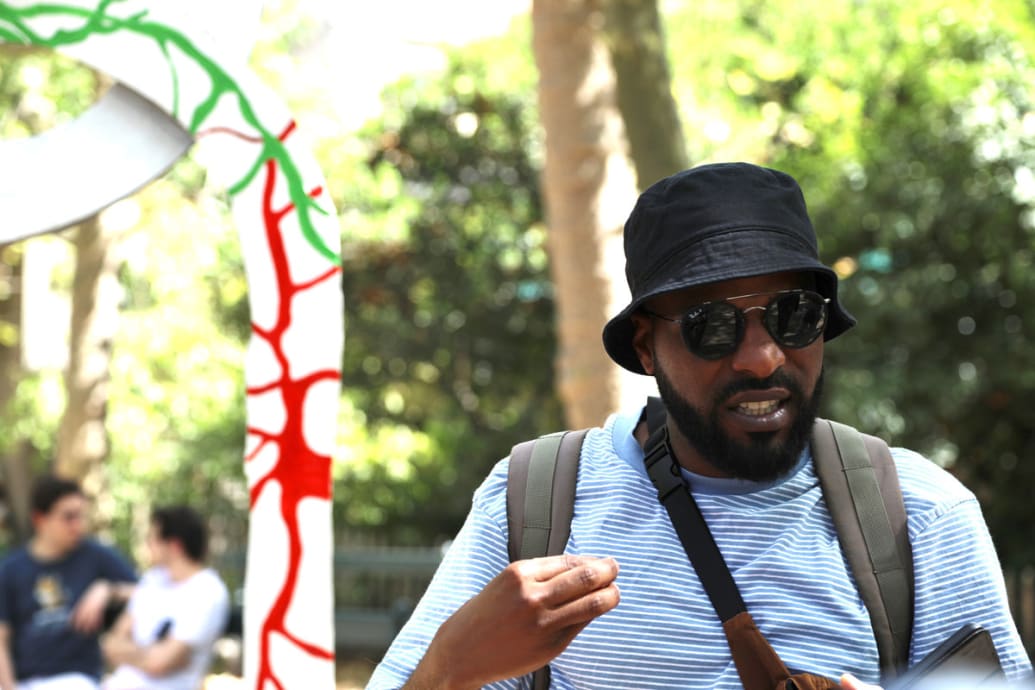A Paris Tour Where You Probably Know as Much as a Parisian
[ad_1]
When Kévi Donat first began leading tours around Paris back in 2011, there was one frustrating question that he would be asked again and again by foreign tourists: “Who is that African-American?”
They would point at a portrait of Aimé Césaire—the hugely influential 20th century Francophone writer, intellectual and politician from the Caribbean island of Martinique—that was on display at the Panthéon, a mausoleum containing some of France’s most illustrious citizens.
“‘Black people exist outside of America!’,” Donat recalls thinking in his head, if not going as far as to berate his guests out loud.
“The US has its own complicated history with race to deal with,” he explains. “But there are many other histories around the world, and the problem is that so many people have no idea about them.”
Although the image of Césaire must admittedly have stood out in a space usually reserved for white faces, the ignorance about the martiniquais and his considerable achievements is in part what led Donat—who was raised in Martinique and moved to France at the age of 13—to start Le Paris Noir, or Black Paris, in 2013.
The concept is simple: to tell the often overlooked Black history of the City of Light.
While Paris has and continues to consistently be one of the most visited cities in the world (the city of two million expects to welcome 33 million tourists in 2022), Donat argues there’s much more to it than the clichés of picturesque boulevards, charming wine bars, and heavily-visited landmarks such as the Eiffel Tower and Notre Dame.
“Paris is a quintessential city of tourism,” says Donat. “It’s famed around the world. A particular image of Paris has been told in films and magazines. But that means most people [who come to visit] already have ideas in mind of what it is or should be.”

In reality, the French capital’s connection to Africa, the Caribbean and the United States—spanning from the awful history of slavery, colonization and immigration to the masses of black literary, political and artistic figures—has largely been swept under the carpet. History is written by the victors, he explains, after all.
“I want to make this alternative history more visible,” says Donat. “If it’s not told by someone, it might be forgotten. But also in telling that history, it means we hopefully have the opportunity to learn from what happened in the past.”
Currently, Le Paris Noir runs two tours, available in French and English. The first is based on La Rive Gauche, or the Left Bank of Paris, and traces a route through classic stops on the Parisian tourist trail with a twist: from the steps of the Pantheon to the Jardin de Luxembourg and Sorbonne University. The second, focusing on La Rive Droite, or the Right Bank, is an entirely different prospect, traversing the lively and diverse 18ème arrondissement neighborhoods of Château Rouge and Goutte d’Or, known for their West and North African populations. By the end of the year, Le Paris Noir will launch a third tour that focuses on the role and importance of statues.
On each of the routes, Donat brings alive those lesser-known histories with engaging storytelling, all the while strolling around in the true Parisian flâneur style.
The Rive Gauche tour, for example, touches on the life of Alexandre Dumas – author of French literary cornerstones such as The Count of Monte Cristo and The Three Musketeers—who was known as a “quarteron” (a child born of a white parent and a mixed-race parent) and suffered discrimination as a consequence. There are nods to Victor Schœlcher, a politician in Guadeloupe and Martinique between 1848 and 1851 who played a leading role in the abolition of slavery, and Félix Éboué, the first black French man appointed to a high post in the French colonies. And there’s room, too, for intellectuals such as W. E. B. Du Bois and Frantz Fanon, the African-American writers Richard Wright and James Baldwin, who lived in Paris during the post-war period, and the pioneering women who defied the gender inequalities of the day such as Josephine Baker, the burlesque dancer-turned-heroine of the French Resistance. In many cases, these histories are as little-known in France as they are abroad.

Donat has a pluralistic, laid-back style to his tours. He poses questions rather than preaching—such as whether it is right for those from former French colonies to apparently need to then come to France for validation through its education systems. He also recommends a prodigious list of podcasts, books, and films for further research. “It’s up to people to make their own minds up,” he says.
Nearly a decade on, and much has changed. Donat, who now runs between 15 and 20 tours a month, says there’s been a steady growth in interest over the years. There’s also been a growth in the kinds of visitors interested in coming on his tours.
“In the first years, the majority of my visitors came from the US,” he says. “But that’s begun to change. There’s been a growth of interest from French people, who now make up the majority of my clients.”
Donat believes that events such as the murder of George Floyd, an African-American man who was killed by a police officer in May 2020 after a store employee claimed he used a counterfeit $20 bill, have played a role in that.
Likewise, events in France—which has long wrangled with its painful past, such as its exploitative relationship with former colonies such as Haiti and the bloody fight for independence in the Algerian War—continue to create turbulence.
Tensions have recently risen over the exclusionary impact of the country’s “color blind” approach to race as well as the idea of “wokeness” and critical race theory, with critics arguing it has been exported to France by the US. In a confirmation of those societal fractures, the French far-right obtained its highest vote share in history during the presidential election in April.
“It’s a difficult situation in France,” says Donat. “I wouldn’t necessarily say I’m an optimist. But I also don’t want to be too dramatic.”

Besides, he says, there are small signs of progress to grasp onto: In May, a statue of Solitude, heroine of the fight against slavery in Guadeloupe, was inaugurated in the 17th arrondissement of Paris—the city’s first ever statue of a black woman.
“We are making little steps forward,” says Donat.
[ad_2]
Read More:A Paris Tour Where You Probably Know as Much as a Parisian

Comments are closed.